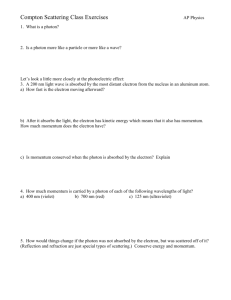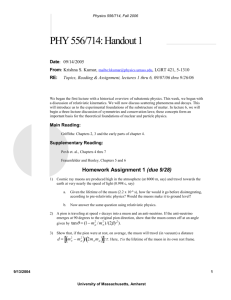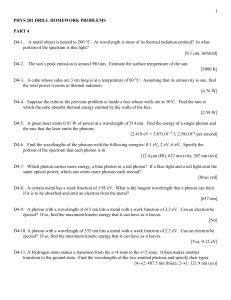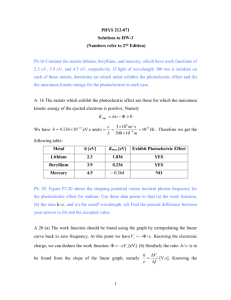WORD - HRSBSTAFF Home Page
advertisement
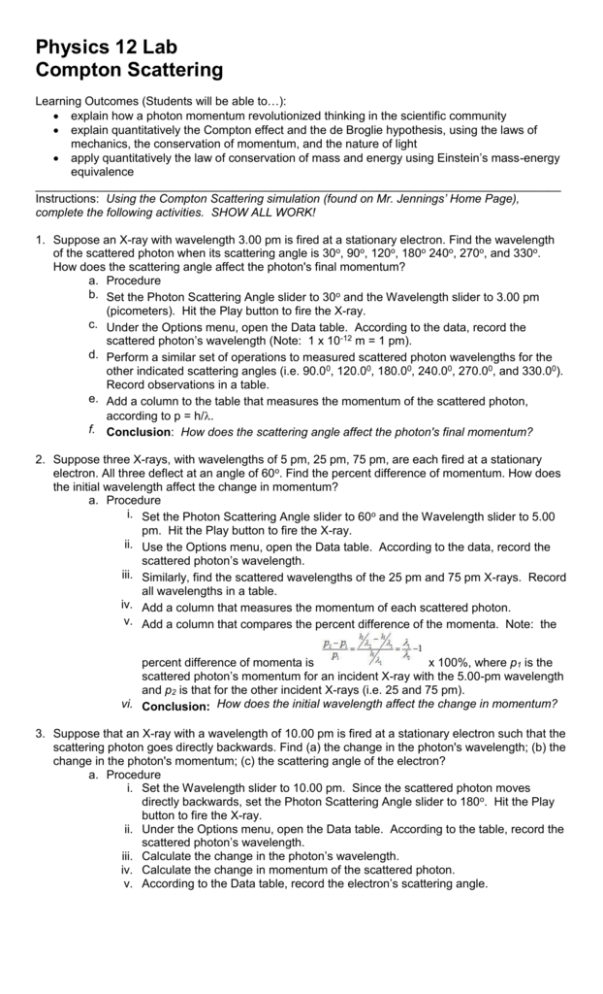
Physics 12 Lab Compton Scattering Learning Outcomes (Students will be able to…): explain how a photon momentum revolutionized thinking in the scientific community explain quantitatively the Compton effect and the de Broglie hypothesis, using the laws of mechanics, the conservation of momentum, and the nature of light apply quantitatively the law of conservation of mass and energy using Einstein’s mass-energy equivalence ________________________________________________________________________________ Instructions: Using the Compton Scattering simulation (found on Mr. Jennings’ Home Page), complete the following activities. SHOW ALL WORK! 1. Suppose an X-ray with wavelength 3.00 pm is fired at a stationary electron. Find the wavelength of the scattered photon when its scattering angle is 30o, 90o, 120o, 180o 240o, 270o, and 330o. How does the scattering angle affect the photon's final momentum? a. Procedure b. Set the Photon Scattering Angle slider to 30o and the Wavelength slider to 3.00 pm (picometers). Hit the Play button to fire the X-ray. c. Under the Options menu, open the Data table. According to the data, record the scattered photon’s wavelength (Note: 1 x 10-12 m = 1 pm). d. Perform a similar set of operations to measured scattered photon wavelengths for the other indicated scattering angles (i.e. 90.00, 120.00, 180.00, 240.00, 270.00, and 330.00). Record observations in a table. e. Add a column to the table that measures the momentum of the scattered photon, according to p = h/. f. Conclusion: How does the scattering angle affect the photon's final momentum? 2. Suppose three X-rays, with wavelengths of 5 pm, 25 pm, 75 pm, are each fired at a stationary electron. All three deflect at an angle of 60o. Find the percent difference of momentum. How does the initial wavelength affect the change in momentum? a. Procedure i. Set the Photon Scattering Angle slider to 60o and the Wavelength slider to 5.00 pm. Hit the Play button to fire the X-ray. ii. Use the Options menu, open the Data table. According to the data, record the scattered photon’s wavelength. iii. Similarly, find the scattered wavelengths of the 25 pm and 75 pm X-rays. Record all wavelengths in a table. iv. Add a column that measures the momentum of each scattered photon. v. Add a column that compares the percent difference of the momenta. Note: the percent difference of momenta is x 100%, where p1 is the scattered photon’s momentum for an incident X-ray with the 5.00-pm wavelength and p2 is that for the other incident X-rays (i.e. 25 and 75 pm). vi. Conclusion: How does the initial wavelength affect the change in momentum? 3. Suppose that an X-ray with a wavelength of 10.00 pm is fired at a stationary electron such that the scattering photon goes directly backwards. Find (a) the change in the photon's wavelength; (b) the change in the photon's momentum; (c) the scattering angle of the electron? a. Procedure i. Set the Wavelength slider to 10.00 pm. Since the scattered photon moves directly backwards, set the Photon Scattering Angle slider to 180o. Hit the Play button to fire the X-ray. ii. Under the Options menu, open the Data table. According to the table, record the scattered photon’s wavelength. iii. Calculate the change in the photon’s wavelength. iv. Calculate the change in momentum of the scattered photon. v. According to the Data table, record the electron’s scattering angle. 4. Suppose that an X-ray with a wavelength of 3.75 pm is fired at a stationary electron such that the scattering angle is 85o. What is the resulting energy of the electron (hint: the energy of a stationary electron is not zero)? a. Procedure i. Set the Photon Scattering Angle slider to 85 deg and the Wavelength slider to 3.75 pm. Hit the Play button to fire the X-ray. ii. Use the Law of Conservation of Energy to find the resulting energy of the electron: where Ep is the energy of the photon and Ee is the energy of the electron. Specifically note that Eei is the rest mass of the electron.
